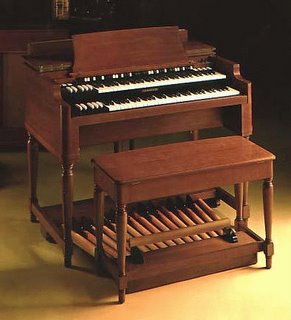Hammond A-100 As A Viable Instrument


Most everyone that would be interested in delving into this article is going to recognize the picture on the left, the king of all organs, the Hammond B3 organ.
And those same enthusiasts will probably recognize the other picture as being a Hammond A-100.
Those same people would immediately recognize the B3 as being more valuable than an A-100. Given a choice they would tend to pick the B3 over the A-100.
Moreover, because of the similarity of the two instruments and the fact that tonewheel Hammond organs and the parts to repair them are no longer in production, hardly a second thought is given to cannabalizing an A-100 to save a B3.
Let's use these pictures to review the differences.
The keyboard assembly is exactly the same. The drawbar arrangement, chorus/vibrato and percussion features are exactly the same. The pedals are the same, and if we were to open up the back of the A-100 we would see all of the internal parts that the B3 has.
The wood case is obviously different. The A-100 has a more compact feel to it, and doesn't overwhelm most standard living rooms as the B3 tends to do.
On the A-100, you may be able to make out the black button located on the far left over the chorus/vibrato knob. It is a similar knob-this turns on and off the reverb. Reverb is not available on vintage B3s.
Another major difference is that below the keyboard on the B3, one can see right through the instrument because of its open leg design.
On the A-100, that area is covered by a speaker assembly.
Many A-100 owners will remove this speaker assembly from the organ as the Hammond is more popularly dependent on the ever popular Leslie speaker.
Last night I got to play a immaculately restored 1960s A-100 through a Leslie 122 style speaker.
Those organs such as this one are customarily fitted with not only a switch to speed up and slow down the rotation in the Leslie, but also to defeat the internal organ speaker, or to have it play along with the Leslie.
This is an amazing effect. Not only does the produce the thick sound that's being directed all over the room, but you're also feeling the sound of the internal speaker through the organ.
And that reverb, there is nothing like hitting a short chord and hearing the decay of the sound in the room.
The A-100 is a viable instrument, possibly being made even more valuable because of the constant raping of these instruments for parts.

